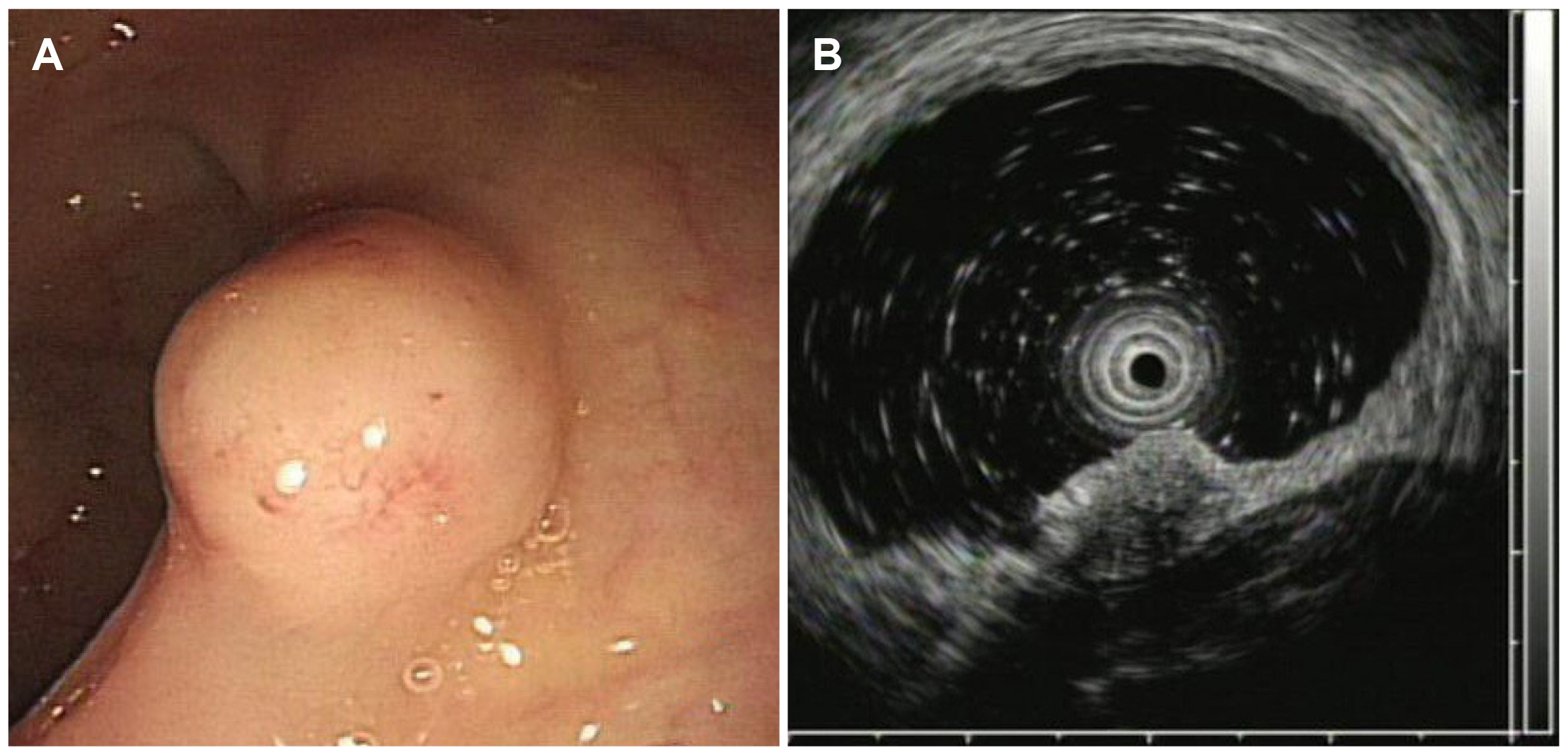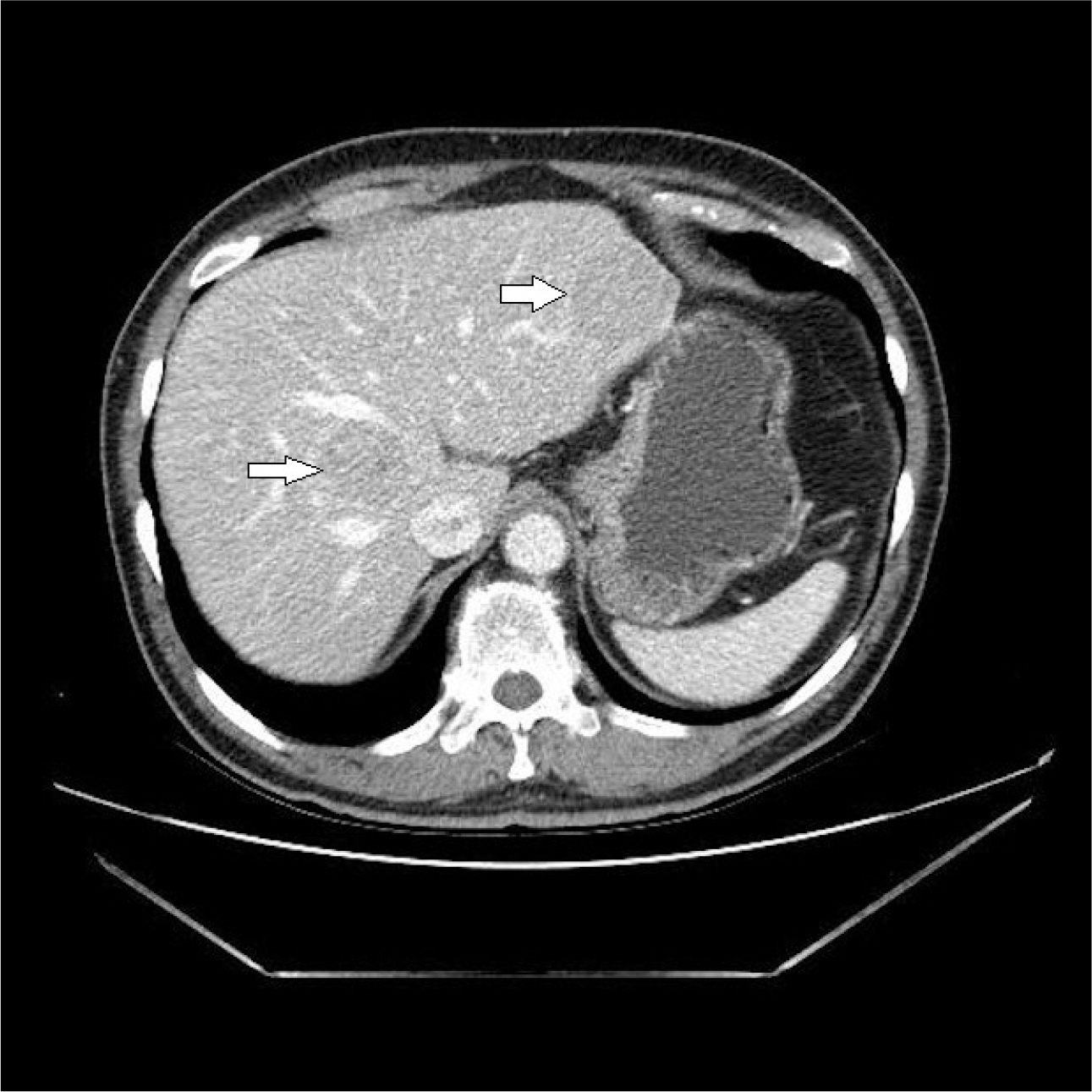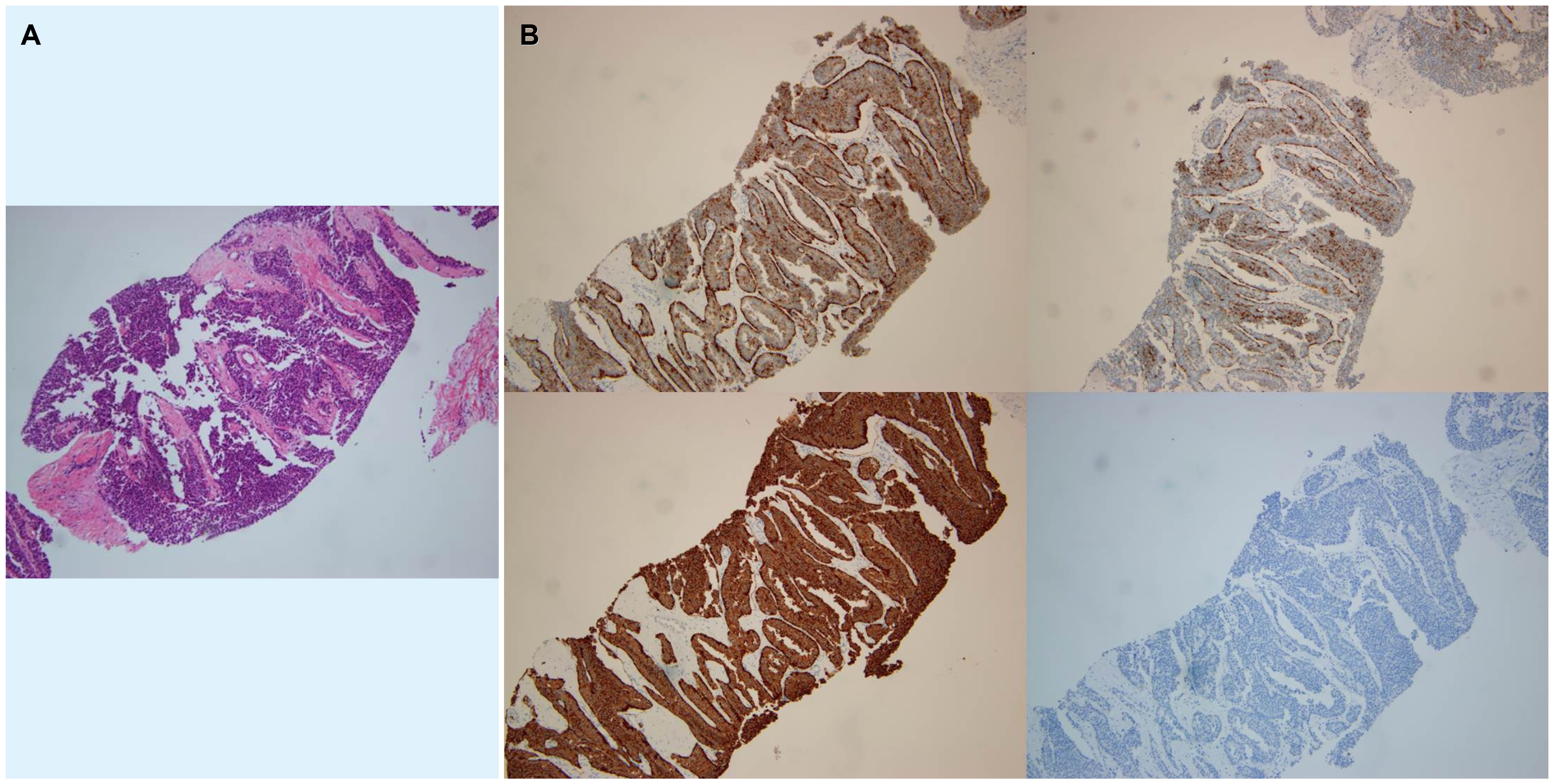Korean J Gastroenterol.
2020 Nov;76(5):251-255. 10.4166/kjg.2020.096.
Low-grade Rectal Neuroendocrine Tumor Recurring as Multiple Hepatic Metastasis after Complete Endoscopic Removal: A Case Report
- Affiliations
-
- 1Department of Internal Medicine, St. Vincent’s Hospital, College of Medicine, The Catholic University of Korea, Suwon, Korea
- KMID: 2508875
- DOI: http://doi.org/10.4166/kjg.2020.096
Abstract
- The World Health Organization classified rectal neuroendocrine tumors (NETs) as malignant in 2010 owing to their distant metastasis potential. On the other hand, in cases of small rectal NETs (<10 mm), which have a low risk of metastasis, endoscopic removal is the first-line therapeutic option, and regular surveillance is not recommended. The authors report a case of a small, well-differentiated rectal NET, which recurred as multiple hepatic metastases 5 years after apparent complete removal using endoscopic methods.
Figure
Reference
-
1. McDermott FD, Heeney A, Courtney D, Mohan H, Winter D. 2014; Rectal carcinoids: a systematic review. Surg Endosc. 28:2020–2026. DOI: 10.1007/s00464-014-3430-0. PMID: 24584484.
Article2. Weinstock B, Ward SC, Harpaz N, Warner RR, Itzkowitz S, Kim MK. 2013; Clinical and prognostic features of rectal neuroendocrine tumors. Neuroendocrinology. 98:180–187. DOI: 10.1159/000355612. PMID: 24080744.
Article3. Anthony LB, Strosberg JR, Klimstra DS, et al. 2010; The NANETS consensus guidelines for the diagnosis and management of gastrointestinal neuroendocrine tumors (nets): well-differentiated nets of the distal colon and rectum. Pancreas. 39:767–774. DOI: 10.1097/MPA.0b013e3181ec1261. PMID: 20664474.4. Rodrigues Â, Castro-Poças F, Pedroto I. 2015; Neuroendocrine rectal tumors: main features and management. GE Port J Gastroenterol. 22:213–220. DOI: 10.1016/j.jpge.2015.04.008. PMID: 28868410. PMCID: PMC5579972.
Article5. Modlin IM, Oberg K, Chung DC, et al. 2008; Gastroenteropancreatic neuroendocrine tumours. Lancet Oncol. 9:61–72. DOI: 10.1016/S1470-2045(07)70410-2. PMID: 18177818.
Article6. Maggard MA, O'Connell JB, Ko CY. 2004; Updated population-based review of carcinoid tumors. Ann Surg. 240:117–122. DOI: 10.1097/01.sla.0000129342.67174.67. PMID: 15213627. PMCID: PMC1356383.
Article7. Bosman FT, Carneiro F, Hruban RH, Theise ND. 2010. WHO classification of tumours of the digestive system. 4th ed. International Agency for Research on Cancer;Lyon:8. Chablaney S, Zator ZA, Kumta NA. 2017; Diagnosis and management of rectal neuroendocrine tumors. Clin Endosc. 50:530–536. DOI: 10.5946/ce.2017.134. PMID: 29207857. PMCID: PMC5719921.
Article9. Yoon SN, Yu CS, Shin US, Kim CW, Lim SB, Kim JC. 2010; Clinicopathological characteristics of rectal carcinoids. Int J Colorectal Dis. 25:1087–1092. DOI: 10.1007/s00384-010-0949-y. PMID: 20397020.
Article10. Neuroendocrine and adrenal tumors. 2019. Jan. 7. [Internet]. NCCN;Plymouth Meeting (PA): Available from: https://www.nccn.org/professionals/physician_gls/pdf/neuroendocrine.pdf. cited 2020 Jan 5.11. Gamboa AC, Liu Y, Lee RM, et al. 2019; A novel preoperative risk score to predict lymph node positivity for rectal neuroendocrine tumors: an NCDB analysis to guide operative technique. J Surg Oncol. 120:932–939. DOI: 10.1002/jso.25679. PMID: 31448820. PMCID: PMC6791747.
Article12. Folkert IW, Sinnamon AJ, Concors SJ, et al. 2020; Grade is a dominant risk factor for metastasis in patients with rectal neuroendocrine tumors. Ann Surg Oncol. 27:855–863. DOI: 10.1245/s10434-019-07848-0. PMID: 31701298.
Article13. Hirose Y, Sakata J, Endo K, et al. 2018; A 0.8-cm clear cell neuroendocrine tumor G1 of the gallbladder with lymph node metastasis: a case report. World J Surg Oncol. 16:150. DOI: 10.1186/s12957-018-1454-y. PMID: 30037336. PMCID: PMC6057040.
Article14. Matsuhashi N, Takahashi T, Tomita H, et al. 2017; Evaluation of treatment for rectal neuroendocrine tumors sized under 20 mm in comparison with the WHO 2010 guidelines. Mol Clin Oncol. 7:476–480. DOI: 10.3892/mco.2017.1326. PMID: 28894583. PMCID: PMC5582451.
Article15. Nagata K, Tajiri K, Shimada S, et al. 2017; Rectal neuroendocrine tumor G1 with a solitary hepatic metastatic lesion. Intern Med. 56:289–293. DOI: 10.2169/internalmedicine.56.7523. PMID: 28154272. PMCID: PMC5348452.
Article16. Atwal D, Joshi KP, Jeffus S, Ntambi J, Mahmoud F. 2017; Well-differentiated neuroendocrine tumor-A low B-grade tumor's aggressive course and dismal outcome: a case report. Perm J. 21:16–193. DOI: 10.7812/TPP/16-193. PMID: 28633725. PMCID: PMC5478591.
Article17. Song JE, Kim BS, Lee CH. 2016; Primary hepatic neuroendocrine tumor: a case report and literature review. World J Clin Cases. 4:243–247. DOI: 10.12998/wjcc.v4.i8.243. PMID: 27574614. PMCID: PMC4983697.
Article
- Full Text Links
- Actions
-
Cited
- CITED
-
- Close
- Share
- Similar articles
-
- A small, low-grade rectal neuroendocrine tumor with lateral pelvic lymph node metastasis: a case report
- Endoscopic treatment for rectal neuroendocrine tumor: which method is better?
- Diagnosis and Management of Rectal Neuroendocrine Tumors
- Endoscopic Treatment Outcome of Rectal Neuroendocrine Tumors Removed by Ligation-assisted Endoscopic Submucosal Resection
- Update of Korean Standard Classification of Diseases for Rectal Carcinoid and Its Clinical Implication





